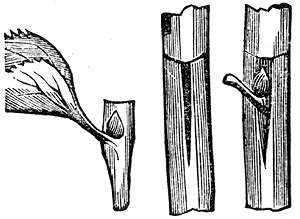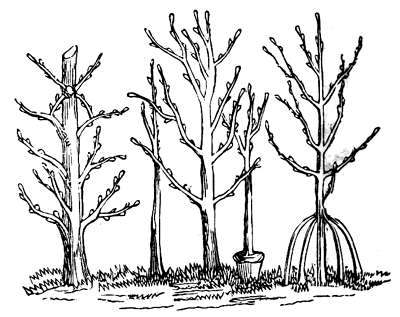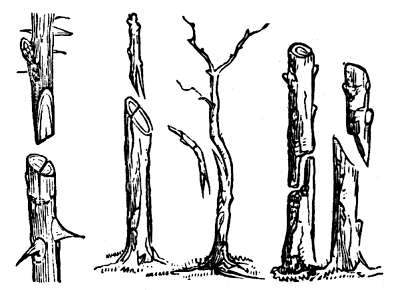from the Household Cyclopedia, 1881
Budding And Grafting.
Budding, or, as it is sometimes called, grafting, by germs, consists in taking an eye or bud attached to a portion of the bark of a ligneous vegetable, of various size and form, and generally called a shield, and transplanting it to another or a different ligneous vegetable. Nurserymen now generally prefer budding to any other mode of propagation. The object in view is precisely that of grafting, and depends on the same principle; all the differences between a bud and a scion being that a bud is a shoot or scion in embryo. Budded trees are two years later in producing their fruit than grafted ones: but the advantage of budding is that, where a tree is rare, a new plant can be got from every eye, whereas by grafting it can only be got from every three or four eyes. There are also trees which propagate much more readily by budding than grafting; and others, as most of the stone fruits, are apt to throw out gum when grafted. Budding is formed from the beginning of July to the middle of August, the criterion the formation of the buds in the axillae of the leaf of the present year.
The buds are known to be ready by the shield, or portion of bark to which they are attached, easily parting with the wood.
Shield Budding
Is performed as follows: Fix on a smooth part on the side of the stock, rather from than towards the sun, and of a height depending, as in grafting, on whether dwarf, half, or whole standard trees are desired; then, with the buddingknife, make a horizontal cut across the rind, quite through the firm wood; from the middle of this transverse cut make a slit downward perpendicularly, an inch or more long, going also quite through to the wood. Proceed with expedition to take off a bud; holding the cutting or scion in one hand, with the thickest end outward, and with the knife in the other hand, enter it about half an inch or more below a bud, cutting nearly half-way into the wood of the shoot, continuing it, with one clean slanting cut, about half an inch or more above the bud, so deep as to take off part of the wood along with it, the whole about an inch and a half long, then directly with the thumb and finger, or point of the knife, slip off the woody part remaining to the bud, which done, observe whether the eye or germ of the kind remains perfect, if not and a little hole appears in that part, the bud has lost its root, and another must be prepared. This done, place the back part of the bud or shield between the lips, and with the flat heft of the knife separate the bark of the stock on each side of the perpendicular cut clear to the wood, for the admission of the bud, which directly slip down, close between the wood and bark, to the bottom of the slit. Next cut off the top part of the shield even with the horizontal cut, in order to let it completely into its place, and to join exactly the upper edge of the shield with the transverse cut, that the descending sap may immediately enter the back of the shield, and protrude granulated matter between it and the wood, so as to effect a living union. The parts are to he bound round with a ligament of fresh bass, previously soaked in water, to render it pliable and tough. Begin a little below the bottom of the perpendicular slit, proceeding upward closely round every part, except just over the eye of the bud, and continue it a little above the horizontal cut, not too tight, but just sufficient to keep the hole close, and exclude the air, sun, and wet.

Another Method of Budding.
Trees are generally budded by making a transverse section in the bark of the stock, and a perpendicular slit beneath it, the bud is then pushed down to give it the position which it is to have. This operation is not always successful, and it is better to employ an inverse or contrary method by making the vertical slit above the transverse section or cut, and pushing the bark containing the bud upwards into its proper position. This method very rarely fails of success, because as the sap descends by the bark, the kind placed above the transverse section receives abundance, whereas if it be placed below the section very little sap can ever get to it to promote the growth of the bud. Oil rubbed upon the stems and branches of fruit trees destroys insects and increases the fruit. buds. Used upon the stems of carnations, it guards them against the depredations of the ear-wig. The coarsest oil will suit, and only a small quantity is required.
To bud with Double Ligatures.
This is an expeditious mode of budding by Mr. T. A. Knight. The operations are performed in the manner above stated, but instead of one ligature two are applied, one above the bud, inserted upon the transverse section, through the bark; the other applied below in the usual way. As soon as the buds have attached themselves the lower ligatures are taken off, but the others are suffered to remain. The passage of the sap upwards is in consequence much obstructed, and the inserted buds begin to vegetate strongly in July (being inserted in June), and when these have afforded shoots about four inches long the remaining ligatures are taken off, to permit the excess of sap to pass on, and the young shoots are nailed to the wall. Being there properly exposed to light, their wood will ripen well, and afford blossoms in the succeeding spring.

To graft Trees.
Figure 2.3: Grafting.
This is a mode of propagation applicable to most sorts of trees and shrubs, but not easily to very small undershrubs, as heath, or herbaceous vegetables. It is chiefly used for continuing varieties of fruit trees. A grafted tree consists of two parts, the scion and the stock; their union constitutes the graft, and the performance of the operation is called grafting.
The end of grafting is, first, to preserve and multiply varieties and sub-varieties of fruit-trees, endowed accidentally or otherwise with particular qualities, which cannot be with certainty transferred to their offspring by seeds, and which would be multiplied too slowly or ineffectually by any other mode of propagation.
Second, to accelerate the fructification of trees, barren as well as fruit bearing; for example, suppose two acorns of a new species of oak received from a distant country; sow both, and after they have grown one or two years cut one of them over and graft the part cut off on a common oak of five or six years’ growth; the consequence will be that the whole nourishment of this young tree of five years’ growth being directed towards nourishing the scion of one or two years, it will grow much faster, and consequently arrive at perfection much sooner than its fellow, or its own root left in the ground, The third use of grafting is to improve the quality of fruits, and the fourth to perpetuate varieties of ornamental trees or shrubs.
Materials used in Grafting.
Procure a strong pruning-knife for cutting off the heads of the stocks previous to their preperation by the grafting-knife for the scion, a small saw for larger stocks, and a penknife for very small scions, chisel and mallet for cleft grafting, bass ribbons for ligatures, and grafting clay.
To prepare Grafting-Clay.
Grafting-clay is prepared either from stiff yellow or blue clay, or from clayey loam or brick earth; in either case adding thereto about a fourth part of fresh horse dung, free from litter, and a portion of cut hay, mixing the whole well together and adding a little water; then let the whole be well beaten with a stick upon a floor or other hard substance, and as it becomes too dry apply more water, at every beating turning it over, and continue beating it well at top till it becomes flat and soft. This process must be repeated more or less according as the nature of the clay may require to render it ductile, and yet not so tough as to be apt to crack in dry weather. Whip Grafting.

Whip, or as it is sometimes called tongue grafting, is the most generally adopted in nurseries for propagating fruit trees. To effect this mode in the best style, the top of the stock and the extremity of the scions should be nearly of equal diameter. Hence this variety admits of being performed on smaller stocks than any other. It is called whip-grafting from the method of cutting the stock and scions sloping on one side so as to fit each other, and thus tied together in the manner of a whip-thong to the shaft or handle.
The scion and stock being cut off obliquely, at corresponding angles, as near as the operator can guess, then cut off the tip of the stock obliquely, or nearly horizontally, make now a slit nearly in the centre of the sloped face of the stock downwards and a similar one in the scion upwards. The tongue or wedge-like process forming the upper part of the sloping face of the scion, is then inserted downwards in the cleft of the stock, the inner barks of both being brought closely to unite on one side, so as not to be displaced in tying, which ought to be done immediately with a riband of brass, brought in a neat manner several times round the stock, and which is generally done from right to left, or in the course of the sun. The next operation is to clay the whole over an inch thick on every side from about half an inch or more below the bottom of the graft to an inch over the top of the stock, finishing the whole coat of clay in a kind of oval globular form, rather longways up and down, closing it effectually about the scion and every part, so as no light, wet, nor wind may penetrate, to prevent which is the whole intention of claying.
Cleft Grafting.
This is resorted to in the case of strong stocks, or in heading down and re-grafting old trees. The head of the stock or branch is first cut off obliquely, and then the sloped part is cut over horizontally near the middle of the slope, a cleft nearly two inches long is made with a stout knife or chisel in the crown downward, at right angles to the sloped part, taking care not to divide the pith. This cleft is kept open by the knife. The scion has its extremity for about an inch and a half, cut into the form of a wedge; it is left about the eighth of an inch thicker on the outer side, and brought to a fine edge on the inside. It is then inserted into the opening prepared for it, and the knife being withdrawn the stock closes firmly upon it.
Crown Grafting.
This is another mode adopted for thick stocks, shortened branches, or headed down trees, It is sometimes called grafting in the bark or rind, fromthe scion being inserted between the bark and wood. This mode of grafting is performed with best effect somewhat later than the others, as the motion of the sap renders the bark and wood of the stock much more easily separated for the admission of the scions.
In performing this operation, first cut or saw off the head of the stock or branch horizontally or level, and pare the top smooth; then having the scions cut one side of each flat and somewhat sloping, an inch and a half long, forming a sort of shoulder at the top of the slope, to rest upon the crown of the stock; and then raise the rind of the stock with the ivory wedge forming the handle of the budding knife, so as to admit the scion between that and the wood two inches down, which done, place the scion with the cut side next the wood, thrusting it down far enough for the shoulder to rest upon the top of the stock; and in this manner may be put three, four, five or more scions in one large stock or branch. It is alleged as a disadvantage attending this method in exposed situations, that the ingrafted shoots for two or three years are liable to be blown out of the stock by violent winds; the only remedy for which is tying long rods to the body of the stock or branch, and tying up each scion and its shoots to one of the rods.
Side Grafting.
This method resembles whip grafting, but differs in being performed on the side of the stock, without bending down. It is practised on wall trees to fill up vacancies, and sometimes in order to have a variety of fruits upon the same tree. Having fixed upon those parts of the branches where wood is wanting to furnish the head or any part of the tree, then slope off the bark and a little of the wood, and cut the lower end of the scions to fit the part as nearly as possible,, then join them to the branch, and tie them with bass and clay them over.
Saddle Grafting.
This is performed by first cutting the top of the Stock into a wedge-like form,, and then splitting up the end of the scion and thinning off each half to a tongue-shape; it is then placed on the wedge embracing it on each side, and the inner barks are made to join on one side of the stock, as in cleft grafting. This is a very strong and handsome mode for standard trees, when grafted at the standard height. It is also desirable for orange-trees and rosestandards, as itmakes a handsome finish, covering a part of the stock, which, by the other methods, long remains a black sear, and sometimes never becomes covered with bark. The stocks fur this purpose should not be much than the scions, or two scions may be inserted.
Shoulder or Chink Grafting.
This is performed with a shoulder, and sometimes also with a stay at the bottom of the slope. It is chiefly used for ornamental trees, where the scion and stock are of the same size.
Root Grafting.
Root grafting is sometimes performed in nurseries on parts of the roots of removed trees, when the proper stocks are scarce; in which case the root of the white thorn has been resorted to as a stock both for the apple and pear. In general however, a piece of the root of the tree of the same genus is selected, well furnished with fibres, and a scion placed on it in any of’ the ordinary ways for small stocks. Thus united, they are planted so deep as to cover the ball of clay, and leave only a few eyes of the scion above ground.
In a month after grafting it may be ascertained whether the scion has united with the stock by observing the progress of its buds, but, in general, it is not safe to remove the clay for three months or more, till the graft be completely cicatrized. The clay may generally be taken off in July or August, and at the same time the ligatures loosened where the scion seems to require more room to expand: a few weeks afterwards, when the parts have been thus partially inured to the air, and when there is no danger of the scion being blown off by winds, the whole of the ligatures may be removed.
To choose Scions.
Scions are those shoots which, united with the stock, form the graft. They should be gathered several weeks before the season for grafting arrives, It is desirable that the sap of the stock should be in brisk motion at the time of grafting; but by this time the buds of the scion, if left on the parent tree, would be equally advanced, whereas the scions, being gathered early, the buds are kept buck, and ready only to swell out when placed on the stock.
Scions of pears, plums and cherries, are collected in the end of January or beginning of February. They are kept at full length sunk in dry earth, and out of the reach of frost till wanted, which is sometimes from the middle of February to the middle of March. Scions of apples are collected any time in February, and put in from the middle to the end of March. In July grafting the scions are used as gathered.